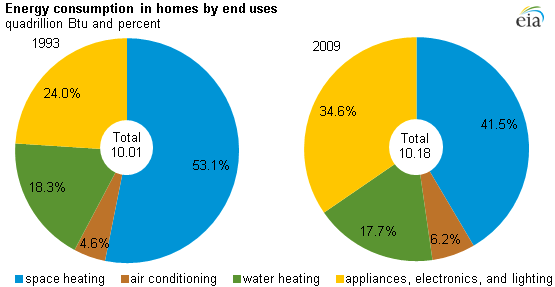Quick Look
Grade Level: 8 (6-8)
Time Required: 4 hours
Six 40-minute class periods (up to six days if all activities are completed). Some time variation; especially depending on prior Excel graphing experience.
Lesson Dependency: None
Subject Areas: Physical Science, Science and Technology
NGSS Performance Expectations:

| MS-ESS3-4 |

Summary
This six-day lesson provides students with an introduction to the importance of energy in their lives and the need to consider how and why we consume the energy we do. The lesson's associated activities engage students in general energy issues, including playing an award-winning Energy Choices board game, and an optional graphing activity that provides experience with MS Excel graphing and perspectives on how we use energy and how much energy we use.Engineering Connection
Devices that engineers design often convert energy into forms that help us do every day activities—from drying our hair to powering the school bus. In the developed world, energy consumption is close to our technological capacity to produce energy useful to consumers. Engineers and all other people must now reconsider how we use energy. We must make and use products that help society, all while consuming less energy.
Learning Objectives
After this lesson, students should be able to:
- Explain how the depletion of fossil fuels is a serious global issue.
- List three decisions and actions they can make/take to reduce their personal energy consumption.
- Use mathematics in other fields, using graphs, computation and models.
Educational Standards
Each TeachEngineering lesson or activity is correlated to one or more K-12 science,
technology, engineering or math (STEM) educational standards.
All 100,000+ K-12 STEM standards covered in TeachEngineering are collected, maintained and packaged by the Achievement Standards Network (ASN),
a project of D2L (www.achievementstandards.org).
In the ASN, standards are hierarchically structured: first by source; e.g., by state; within source by type; e.g., science or mathematics;
within type by subtype, then by grade, etc.
Each TeachEngineering lesson or activity is correlated to one or more K-12 science, technology, engineering or math (STEM) educational standards.
All 100,000+ K-12 STEM standards covered in TeachEngineering are collected, maintained and packaged by the Achievement Standards Network (ASN), a project of D2L (www.achievementstandards.org).
In the ASN, standards are hierarchically structured: first by source; e.g., by state; within source by type; e.g., science or mathematics; within type by subtype, then by grade, etc.
NGSS: Next Generation Science Standards - Science
| NGSS Performance Expectation | ||
|---|---|---|
|
MS-ESS3-4. Construct an argument supported by evidence for how increases in human population and per-capita consumption of natural resources impact Earth's systems. (Grades 6 - 8) Do you agree with this alignment? |
||
| Click to view other curriculum aligned to this Performance Expectation | ||
| This lesson focuses on the following Three Dimensional Learning aspects of NGSS: | ||
| Science & Engineering Practices | Disciplinary Core Ideas | Crosscutting Concepts |
| Construct an explanation that includes qualitative or quantitative relationships between variables that describe phenomena. Alignment agreement: | Typically as human populations and per-capita consumption of natural resources increase, so do the negative impacts on Earth unless the activities and technologies involved are engineered otherwise. Alignment agreement: | All human activity draws on natural resources and has both short and long-term consequences, positive as well as negative, for the health of people and the natural environment. Alignment agreement: |
International Technology and Engineering Educators Association - Technology
-
Much of the energy used in our environment is not used efficiently.
(Grades
6 -
8)
More Details
Do you agree with this alignment?
-
Analyze how different technological systems often interact with economic, environmental, and social systems.
(Grades
6 -
8)
More Details
Do you agree with this alignment?
State Standards
National Science Education Standards - Science
-
Causes of environmental degradation and resource depletion vary from region to region and from country to country.
(Grades
5 -
8)
More Details
Do you agree with this alignment?
-
Human activities also can induce hazards through resource acquisition, urban growth, land-use decisions, and waste disposal. Such activities can accelerate many natural changes.
(Grades
5 -
8)
More Details
Do you agree with this alignment?
New York - Science
-
Construct an argument supported by evidence for how increases in human population and per-capita consumption of natural resources impact Earth's systems.
(Grades
6 -
8)
More Details
Do you agree with this alignment?
Introduction/Motivation
We currently are highly dependent on fossil fuels for most of our energy supply—this energy is instrumental for maintaining our current society. However, our supply of non-renewable energy sources is being depleted and may even reach a point at which its limited supply adversely affects our lives. The rapid depletion of fossil fuels stems in part from our current energy use habits. For example, the average American uses six times the amount of energy as the global average. Another way to describe this is that we use one million dollars worth of energy every minute in the US.
We can work to continue to use energy as appropriate in our everyday lives, but we need to make changes to conserve energy, use energy more efficiently or provide additional renewable energy resources that are technologically available to consumers. As individuals, we can make changes in our own lives and we can make decisions about our future profession to help solve our growing energy crisis.
(Introducing these statistics and the importance of energy in our lives can be accomplished with one of two engaging activities. It is critical for students to appreciate the importance of energy in their lives early in the unit. Starting the class with questions like "How did you get to school today?" or "What energy did you use this morning to get ready for school?" and "Where did that energy come from?" are good ways to get the students started thinking about energy topics. The associated activities: Energy Intelligence Agency and Energy in Our Lives Carousel, are excellent ways to begin this discussion and further explore facts about energy usage. Students can then further their understanding of types of energy used as well as futher quantify their usage with the fun and engaging associated activities: Energy Choices Game and Energy Perspectives.
Information published by the US DOE on their kids' energy web page is the best place to find information and interesting energy facts for middle school aged students.)
Lesson Background and Concepts for Teachers
People in the US use, on average, six times the energy consumed by the average of all other people in the world. This energy is consumed in three primary ways: buildings (residential and commercial), transportation, and industry (see Figure 1). Each of these sectors is responsible for approximately one-third of the total energy our nation consumes.

This national energy consumption includes all the energy we use as individual consumers, and all of the energy required to run businesses and industry. Figure 2 shows how our energy usage has changed from 1993 to 2009. Heating and cooling still contributes the most to household energy consumption. Thus, insulating a house is often the most effective way to reduce household energy consumption.

When we buy items, whether it's food grown on the opposite side of the country, or an automobile, a lot of energy is consumed in the production and manufacturing of these goods. The energy that is consumed in the "upstream" processes, is often called the embodied energy. It is important to consider this energy ,too, not just the energy consumed when using a product. For example, consuming food requires energy for growing the food (producing fertilizer, tractor fuel), transportation (refrigerated trucking), processing, storage, and cooking, among others.
Overall, the key concepts that are most critical for this lesson include:
- Energy is a critical resource that is used in all aspects of our daily lives.
- Currently, society is highly dependent upon nonrenewable energy resources, mainly fossil fuels.
- The world's supply of nonrenewable resources is limited and their use can negatively affect our environment and economy.
- Our personal choices affect the future of the world's energy.
- Making smart energy decisions today are beneficial later.
- Energy is consumed not only when we plug an appliance into an outlet or turn on our cars (direct energy use), but also through the production and transportation of material goods that we purchase and consume every day (indirect energy use).
Associated Activities
- Energy Intelligence Agency - A short game in which students find energy facts among a variety of bogus clues.
- Energy in Our Lives Carousel - A short activity in which students brainstorm about how and why they use energy in their lives.
- Energy Choices Game - A board game that takes players through a variety of energy choices encountered in typical households. Students pay gasoline and home energy bills and make choices about cars, appliances and renewable energy systems for their homes.
- Energy Perspectives - How much energy do you use? This MS Excel graphing activity helps students better understand the magnitude of how much energy we use, what types of energy we use, and for what activities.
Assessment
See discussion questions throughout all activity sheets that provide insightful questions to assess if the class as a whole understands the basic concepts.
Lesson Summary Assessment: After game discussion is completed, have students complete a five-minute quiz: "List three energy choices that you would make the next time you played this game (or in your own lives) to reduce the cost and impact of your energy consumption."
Homework: Have students pass in graphs and answers to discussion questions related to the graphing activity.</
Subscribe
Get the inside scoop on all things TeachEngineering such as new site features, curriculum updates, video releases, and more by signing up for our newsletter!More Curriculum Like This

Students complete three different activities to evaluate the energy consumption in a household and explore potential ways to reduce that consumption. The focus is on conservation and energy efficient electrical devices and appliances. The lesson reinforces the relationship between power and energy a...

Students utilize data tables culled from the US DOE Energy Information Agency to create graphs that illustrate what types of energy we use and how we use it.

Several activities are included to teach and research the differences between renewable and non-renewable resources and various energy resources. Students work with a quantitative, but simple model of energy resources to show how rapidly finite, non-renewable energy sources can be depleted, compared...

Students play a board game to learn the concepts of energy use in our lives and the very real impact that personal choices can have on our energy consumption, energy bills and fuel supply.
References
Energy Information Administration, EIA Kid's Page – Energy Facts. US DOE, Accessed December 29, 2008. http://www.eia.doe.gov/kids/energyfacts/index.html
Other Related Information
This lesson was originally published by the Clarkson University K-12 Project Based Learning Partnership Program and may be accessed at http://internal.clarkson.edu/highschool/k12/project/energysystems.html.
Copyright
© 2013 by Regents of the University of Colorado; original © 2008 Clarkson UniversityContributors
Susan Powers; Jan DeWaters; and a number of Clarkson and St. Lawrence University students in the K-12 Project Based Learning Partnership ProgramSupporting Program
Office of Educational Partnerships, Clarkson University, Potsdam, NYAcknowledgements
This lesson was developed under National Science Foundation grants no. DUE 0428127 and DGE 0338216. However, these contents do not necessarily represent the policies of the National Science Foundation, and you should not assume endorsement by the federal government.
Last modified: August 16, 2023







User Comments & Tips